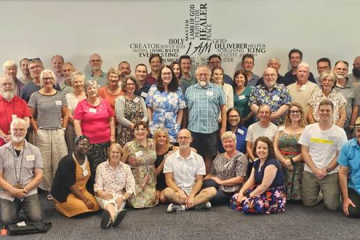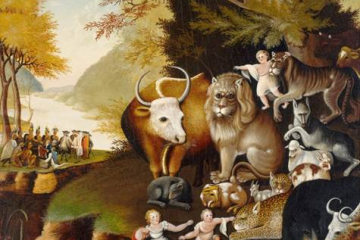Luke 24 26-48
Some bright morning when this life is over, I’ll fly away.
To that land on God’s celestial shore, I’ll fly away.
I’ll fly away, oh glory! I’ll fly away.
When I die, hallelujah, by and by. I’ll fly away.
I can’t do justice to the ethereal beauty of Alison Krauss singing that on the O Brother Where Art Thou soundtrack. (Grace and Zach were watching it again this week.) And I have not written books, as previous ministers of this church have done, on the nature of the resurrection, and I don’t know where all of you sit on the question of whether the resurrection was a bodily event or a figurative description of victory over evil, of a spiritual and psychological enlivening of a community with new hope of God present with them.
But there is nothing ethereal or metaphorical or disembodied about Jesus’ post-resurrection appearances in Luke. Here is a Jesus who, although able to appear and disappear, goes for long walks, sits down at tables, tears loaves of bread, invites them to touch him and finally – to put all their notions of a spirit or ghost to rest – does the most ordinary human thing possible – asks if there’s any food in the house and eats a piece of broiled fish. Ghosts don’t eat broiled fish.
These stories are designed to confirm faith in the resurrection: that Jesus has been vindicated by God, that the life of Jesus goes on and that his disciples, we, as his disciples, are to continue that work. It may be we do not need proof stories to take in this reality and to take on this commission, but what these stories also do is reassert that God does not despise human flesh, but that – as from the beginning – God declares creation good. Good is the flesh. And so the resurrected Christ is not a disembodied spirit – but a real body.
Writer Debie Thomas says, “The Jesus of Easter is the Jesus of the Incarnation. The Jesus who grows in a womb…and nurses at Mary’s breast. The Jesus who…loses his parents during Passover and goes through puberty in the backwaters of Nazareth. The Jesus who soaks in the waters of baptism, hungers for bread in the Judean wilderness, weeps at his friend’s grace, flings a whip around the temple, appreciates scented oils on his feet and head, sweats blood in the garden of Gethsemane, and suffers asphyxiation on a Roman cross. “It is I myself,” Jesus tells his wonderstruck disciples as they struggle to reorder all that they know about life and death, souls and bodies, in the aftermath of his astonishing appearance. It is I myself. Me. The one you know. The one you love. The one you trust. Touch me and see.”
Jesus’ resurrection as a body reaffirms for us that our physical existence, earthly existence is real and significant.
And reading this passage I am struck not just by the description of ordinary human activities; talking, seeing, touching, eating, but also the description of ordinary human emotion; being startled and terrified, frightened, and doubting, still disbelieving and wondering. Jesus is not calling super-natural, super-human disciples, but very natural, very human disciples, people that share the same range of emotions that all of us feel at different times. Just as we are, Jesus calls us, commissions us, to be his witnesses.
Jesus’ resurrection as a body also reminds us that Jesus knows the suffering of our bodies.
We’ve all had the experience of trying to recognise people we know from a distance or in a crowd or after a long time. When I pick up Zach after school, the kids all emerge wearing the same sort of clothes, and I’m looking for the right height, the right walk, the right colour hair. An American friend, Lynda, who taught English in Japan, tells a wonderful story of arranging to meet up with her college roommate’s brother’s penpal in Tokyo. All she had to go on was an old photo of Kazuhiro from school and all she could remember was he had nice knees but surrounded by salary men in suits at Shinjuku Station the knees thing didn’t help her much. She, however, has Dutch ancestry, and bright blond hair. He found her rather easily.
What Jesus says to his friends, how he asks them to recognise him is “Look at my hands and my feet…” Jesus is identified by the marks of his suffering on his body. As Hebrews4:15 says, we have a high priest, a Saviour, who identifies with our weakness.
In another commentary on this passage, Debie Thomas, who I quoted earlier tells the story of the time she and her husband were in the wrenching position of having to hospitalize their then eleven-year-old daughter, who was suffering severe mental health issues. The morning they checked her into the residential facility and walked away, she remembers as one of the worst in her life. The next day she wandered into a Christian bookstore, hoping, to surround herself with the symbols of a faith she could no longer muster. A saleswoman came up to her and asked if she needed help. She just started crying and the woman touched her on the back and then went to a jewellery cabinet, rummaged around for a minute, and came back with a crucifix on a slender silver chain. A tiny Jesus hung on his cross, his face drawn in pain. “Wear this,” she said, pressing the necklace into her hands. “Only a suffering God can help.”
The line belongs to Dietrich Bonhoeffer. Supposedly a prison guard found a piece of paper with the line scribbled on it and smuggled it out of Bonhoeffer’s cell shortly before his death. Only a suffering God can help.
We know in the bodiliness of the risen Lord that our God knows exactly what it is to be human; to feel fear and uncertainty, to know shame, the rejection of others, the humiliation of public disgrace, to know suffering, to know death. We know that our God knows what we are going through.
And it is after they have grasped that Jesus has a physical form, that he can be touched, that he can eat, that he carries the marks of his suffering, that the disciples are able to understand – that their minds are opened to the Scriptures, all the Old Testament scriptures that pointed to the reality – a difficulty reality for the early church to grasp – a difficult reality for a success obsessed contemporary church to grasp – that our God is a God who suffers for us, who suffers with us, who is identified by the signs of his weakness.
But it is as a suffering God, a God who has entered the depths of human experience, who has entered the depths of human hell, that Jesus redeems us. The Scriptures tell us he suffered, as we do, and he rose from the dead, as we will, and that this is now our witness that our God shares every aspect of our human lives and shares every aspect of his life with us, that he has lavished love on us as our New Testament reading says; that our God loves our bodies, suffers with our bodies and redeems our bodies. This is the message of repentance and release, freedom and forgiveness that we are to live out, and we are to tell. We are witnesses of these things.
It would be so much easier to just fly away – as the song said – to die and go to heaven, but we serve a God whose risen form shows us that our world, our existence is real and significant; that our ministry and witness, just like Jesus’ ministry and witness, to is honour bodies, to suffer with bodies and see bodies redeemed.
The work and the witness of the resurrection begins now, in the real world.


